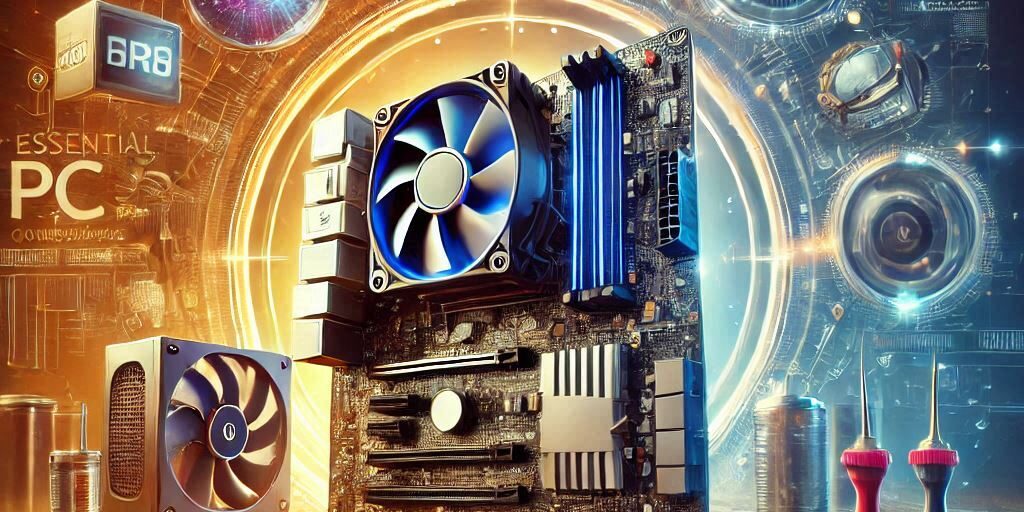Building a custom PC is a rewarding experience that gives you control over every aspect of your machine. However, understanding the essential components and their roles is crucial to creating a system that meets your needs.
In this comprehensive guide, we’ll break down the key hardware required for a custom PC build, explain their functions, and offer practical tips for selecting the right parts. Whether you’re building a high-performance gaming rig or a workstation for productivity, this article will help you get started.
Essential Components for a Custom PC Build
1. CPU (Central Processing Unit)
What is the CPU?
The CPU, often referred to as the brain of the computer, performs all the calculations required to execute instructions from applications and the operating system.
Key Functions:
- Processes tasks and executes commands.
- Determines overall system speed and performance.
- Handles multitasking and heavy workloads.
How to Choose a CPU:
- Intel vs AMD: Choose based on performance and budget.
- Core Count and Clock Speed: Higher cores and faster speeds improve multitasking and gaming.
2. GPU (Graphics Processing Unit)
What is the GPU?
The GPU handles rendering images, videos, and animations, making it critical for gaming, graphic design, and video editing.
Key Functions:
- Renders high-quality graphics.
- Supports advanced visual effects and 3D rendering.
- Enhances performance in GPU-intensive applications.
How to Choose a GPU:
- Match your GPU to your display resolution and refresh rate.
- Consider VRAM (Video RAM) for smoother performance in high-end tasks.
3. Motherboard
What is the Motherboard?
The motherboard connects all components, acting as the backbone of your PC.
Key Functions:
- Facilitates communication between components.
- Houses critical ports and expansion slots.
- Provides BIOS/UEFI for system setup and configuration.
How to Choose a Motherboard:
- Ensure compatibility with your CPU and other components.
- Look for features like Wi-Fi, overclocking support, and USB ports.
4. RAM (Random Access Memory)
What is RAM?
RAM is short-term memory that stores data for active processes and applications.
Key Functions:
- Allows quick access to frequently used data.
- Improves multitasking and system responsiveness.
How to Choose RAM:
- Opt for at least 16GB for gaming and productivity tasks.
- Match the speed (measured in MHz) to your motherboard’s capabilities.
5. Storage Drives
Types of Storage:
- HDD (Hard Disk Drive): Cost-effective for larger storage needs.
- SSD (Solid-State Drive): Faster read/write speeds for operating systems and games.
Key Functions:
- Stores operating system, applications, and files.
- Affects system boot time and application loading speed.
How to Choose Storage:
- Use an SSD for the OS and frequently used applications.
- Add an HDD for larger file storage.
6. Power Supply Unit (PSU)
What is the PSU?
The PSU converts electrical energy to power your PC components.
Key Functions:
- Supplies stable power to all hardware.
- Protects components from power fluctuations.
How to Choose a PSU:
- Calculate your system’s wattage needs using an online tool.
- Look for 80 Plus certification for energy efficiency.
7. PC Case
What is the PC Case?
The case houses all your components and provides airflow.
Key Functions:
- Protects components from dust and damage.
- Ensures proper airflow and cooling.
How to Choose a Case:
- Match the size to your motherboard (ATX, Micro-ATX, Mini-ITX).
- Choose one with good cable management and ventilation.
8. Cooling Solutions
Types of Cooling:
- Air Cooling: Affordable and effective for most builds.
- Liquid Cooling: Ideal for high-performance systems.
Key Functions:
- Maintains optimal temperatures.
- Prevents overheating and thermal throttling.
9. Input/Output Devices
What are I/O Devices?
I/O devices include peripherals like monitors, keyboards, mice, and speakers.
Key Functions:
- Enable user interaction with the PC.
- Enhance the overall user experience.
10. Operating System (OS)
Why is the OS Important?
The OS manages hardware and software resources, providing the interface you interact with.
Popular Options:
- Windows: Best for gaming and versatility.
- Linux: Preferred for developers and customisation.
- MacOS: Limited to Apple hardware.
The Importance of Component Compatibility
Ensuring compatibility between components is critical to a successful build. Use online tools like PCPartPicker to verify that your chosen parts work together.
Steps to Assemble a Custom PC
- Prepare your workspace and tools.
- Install the CPU, RAM, and cooler onto the motherboard.
- Mount the motherboard in the case.
- Connect storage, PSU, and GPU.
- Cable manage for airflow and aesthetics.
- Boot and install the operating system.
Tips for Choosing the Right Components
- Research benchmarks for performance comparisons.
- Prioritise quality over budget for critical parts like PSU and motherboard.
- Read reviews to ensure reliability.
Common Mistakes to Avoid in a Custom Build
- Skimping on the PSU quality.
- Neglecting airflow and cooling.
- Forgetting to check component compatibility.
Conclusion and Call to Action
Understanding the essential components of a custom PC and their roles is the first step towards building a reliable and high-performance system. Whether you’re a gamer, professional, or hobbyist, a well-built custom PC can deliver unparalleled value.
At Perth Computer Experts, we’re here to assist you in building your perfect PC. Contact us today for expert advice, component recommendations, or professional assembly services tailored to your needs!




